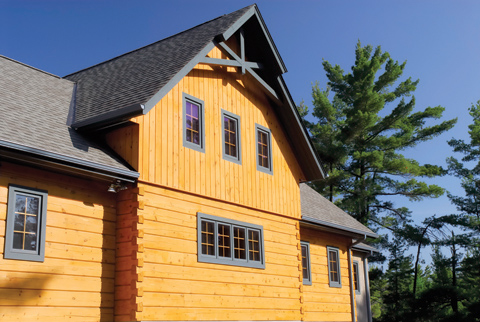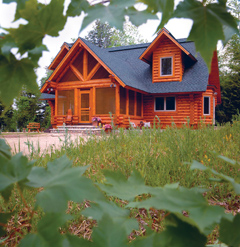Log home preservatives are primary weapons in the fight against wood decay and wood-ingesting insects, safeguarding these structures from the ravages of potentially destructive agents that can damage the beauty and integrity of wood over time.
Damage from wood-ingesting insects such as termites, carpenter ants, or wood-boring beetles can be devastating and costly to repair. Fungi, mold, and mildew can cause wood to rot and eventually need to be replaced or create unsightly stains and discoloration that detract from the visual appeal of a log home. In either case, a wood preservative can stop the problem in its tracks.
“There are only a handful of preservatives out there, and these products must be registered with the EPA (Environmental Protection Agency),” explains Barbara Murray, owner of CTA Products Group. “Three major types of wood preservatives are being used in the log home industry. These are borates that are either pressure impregnated into the wood, dipped at the factory, or mixed with water or glycol and applied after construction; copper 8 quinolinolate, which goes on as a stain, sinks into the cellulose of the wood, and is permanent; and iodocarbanate, often referred to as IPBC, that has no insecticidal properties but is a good fungal treatment that goes on as a stain.”
 Discovery Dream Homes
Discovery Dream HomesBorates are the most widely used wood preservatives in the log home industry today. The natural moisture of the wood carries boric acid, borax, or boron salts, depending on the product, into the wood fibers to protect against moisture, which promotes wood decay. Since borates are water soluble, they are best used along with a protectant that seals the wood against the introduction of external moisture.
“Log homes are sometimes built using high moisture content wood, or in areas where insects or a wet environment exists,” remarks Sjoerd Bos, vice president of Sansin Corporation. “It can sometimes take years for logs to dry out, and in this time or times when they are wet from the environment, moisture can lead to decay and be a breeding ground for insects, fungi, and mildew. Preservatives will help protect against degradation.”
Environmentally friendly borates are favored due to their low toxicity, but they should not be used in direct contact with soil since the moisture in the soil is likely to extract the borate from the wood over the course of a few years, allowing insect infestation or fungus to establish itself. Wood-ingesting insects rely on bacteria in their digestive tracts to digest cellulose. Borates kill these bacteria, eliminating the insects over a period of weeks. Therefore, it is common for insects to remain active for a while following the treatment of the wood. Boron is effective against fungi by disrupting the production of enzymes that extract nutrients from the wood.
 Hiawatha Log Homes
Hiawatha Log Homes“The success rate of properly applied borate treatments is truly astounding. Once insects are eliminated from the wood, it will be protected from future infestations as long as the boron remains within the wood’s cellular structure,” comments Nadia O’Hara of Perma-Chink Systems. “As opposed to insects, a borate treatment will kill decay fungi rather rapidly, usually within a day or two.”
While surface protectants are likely to require follow-up applications over time, when it comes to wood preservatives a single treatment is usually sufficient. “Most of the time, treating once with a preservative is enough, and then with the protectant the minute it starts to wear away, peel, or flake off you have to get some more in there,” advises Murray. “That is the general answer, but every product has its own little twists. Follow the instructions on the package.”
Those who choose to build a home with logs that have not been treated with a wood preservative are taking an unnecessary risk. They must plan to be more vigilant against the weathering of their protectant, coating, finish, or water repellent. In the absence of a preservative, moisture can set up shop, and within a short period the wood is under attack. Taking the time to understand the benefits of log home preservatives and to monitor the condition of the home’s exterior can eliminate problems before they become major headaches, or even prevent them entirely.
The use of a wood preservative serves as a basic backup plan so that the homeowner is not simply counting on a protectant to maintain the good looks and structural integrity of their significant investment. Consulting a log home professional will also help in choosing the proper preservative.
Photography by Roger Wade Studio

